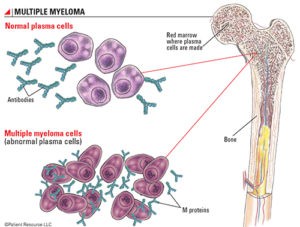“Secondary cancers now make up the sixth-most-common group of malignancies, in part because more (myeloma) survivors are living longer…
“As many as 10% of cancer survivors are developing treatment-related secondary cancers.” Not to put too fine a point on that last comment, 10% of cancer survivors today would be 1.55 million people. I am a multiple myeloma (MM) survivor who lives with the very real possibility of treatment-related secondary cancer as a multiple myeloma side effect from toxic induction, consolidation and a stem cell transplant I underwent from 2/94-9/97.

I am a long-term survivor of an incurable cancer called multiple myeloma. I have no problem with a cancer therapy that cures one disease but may cause another disease 5,10, or 15 years in the future.
What I do have a problem with is FDA approved chemotherapy that causes a secondary cancer 10% of the time, on average, that works only some of the time and never cures a MM patient-ever.
Or a therapy that may put the cancer patient into remission for only a short time and that patient eventually develops MDR aka multi-drug resistence.
Ed. Note–when I originally wrote this post in early 2014, induction therapy, ASCT and low-dose maintenance therapy were not as effective as they are today in late 2019. More than 90% of newly diagnosed MM patients will achieve some form of remission.
The multiple myeloma side effect however, of secondary cancer risk continues to be an issue.
My MM experience is more common than you might think. I was diagnosed in early 1994, underwent aggressive conventional therapies including an autologous stem cell transplant, reached partial remission, relapsed, remission, relapse and “we can do nothing more for you.” My oncologist told me that in September of 1997.

I then researched and underwent a series of evidence-based, non-toxic, non-conventional therapies. I have been living in complete remission since April of 1999.
Having undergone high-dose chemotherapy and radiation, I have a real risk of secondary cancer as a long-term multiple myeloma side effect.
I continue to live an evidence-based but non-conventional anti-cancer lifestyle through nutrition, exercise, supplementation, bone health and other lifestyle therapies.
I believe my anti-cancer, anti-MM lifestyle keeps me in complete remission and also reduces my risk of secondary cancer.
If you would like to learn more about living an evidence-based, non-toxic, anti-cancer lifestyle scroll down the page, post a question or comment and I will reply to you ASAP.
Thank you,
David Emerson
- Multiple Myeloma Survivor
- MM Cancer Coach
- Director PeopleBeatingCancer
Recommended Reading:
“We have carried out the largest randomised trial to date of newly diagnosed myeloma patients, in which lenalidomide has been used as an induction and maintenance treatment option and here report its impact on second primary malignancy (SPM) incidence and pathology.
After review, 104 SPMs were confirmed in 96 of 2732 trial patients. The cumulative incidence of SPM was 0.7% (95% confidence interval (CI) 0.4–1.0%), 2.3% (95% CI 1.6–2.7%) and 3.8% (95% CI 2.9–4.6%) at 1, 2 and 3 years, respectively.
Patients receiving maintenance lenalidomide had a significantly higher SPM incidence overall (P=0.011). Age is a risk factor with the highest SPM incidence observed in transplant non-eligible patients aged >74 years receiving lenalidomide maintenance.
The 3-year cumulative incidence in this group was 17.3% (95% CI 8.2–26.4%), compared with 6.5% (95% CI 0.2–12.9%) in observation only patients (P=0.049).
There was a low overall incidence of haematological SPM (0.5%). The higher SPM incidence in patients receiving lenalidomide maintenance therapy, especially in advanced age, warrants ongoing monitoring although the benefit on survival is likely to outweigh risk…”
“The Food and Drug Administration has added a warning about second-cancer risk to the label of lenalidomide, a widely used multiple myeloma drug, after a safety reviewlasting about 1 year.
Treatment with lenalidomide (Revlimid) for newly diagnosed multiple myeloma is associated with almost a threefold increased risk of developing secondary primary malignancies, the agency announced on May 7. The finding was based on three postapproval trials of lenalidomide as maintenance therapy in newly diagnosed patients.
“Specifically, these trials showed there was an increased risk of developing acute myelogenous leukemia, myelodysplastic syndromes, and Hodgkin lymphoma,” the FDA said. No increase was seen in incidence of nonmelanoma skin cancers and solid tumors…”
New Cancer Threat Lurks Long After Cure
MDS is a potentially fatal condition that can be caused by radiation and chemotherapy, both of which Ms. Roberts had in her initial cancer treatment. In medical-speak, it’s a “secondary cancer.” As a cancer and chemo survivor, I know that I, too, have a higher likelihood of developing these cancers.
Tracking Chemotherapy’s Effects on Secondary Cancers
“As treatments have increased survival times substantially in the past two decades, as many as 10% of cancer survivors are developing treatment-related secondary cancers…
One challenge in determining the effect of chemotherapy on secondary cancers is that most drug studies are funded for no more than 5 years, and these cancers can have a latency period of 5–10 years—and longer for radiotherapy. Also, some studies do not distinguish between chemotherapy, radiation, or both…”




